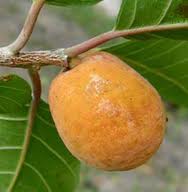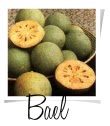As a member of the Artocarpus genus, lakoocha’s relatives
include jackfruit, breadfruit, breadnut and the cempedak. Indeed, this
odd-shaped fruit bears resemblance to these relatives in several ways.
Origin of Lakoocha
Lakoocha’s
origin is India, specifically the sub-Himalayan region. Though lakoocha’s
genetic diversity isn’t well-documented, geneticists in West Bengal found great
variation in the fruit’s size, color and shape, and even hairs: Whereas some
have tough and brown hairs, others have soft and yellow ones. As explained in
the book, “Dhanapala and His Times,” lakoocha was referenced in Indian texts dating
from 750 to 1200 AD, including in the Pauma-cariu
and Bhavisayattakaha.
Lakoocha’s
habitat has remained within the Asian countries of Bangladesh, Bhutan,
Cambodia, India, Laos, Malaysia, Myanmar, Nepal, Sri Lanka, Thailand,
Singapore, and Vietnam.
Most
of these countries value lakoocha not for the fruit, but its wood. Lakuch wood
is exceptionally valuable in making furniture, boats, and cabinets. Though not
as well known as teakwood, it shares most of this wood’s positive qualities
with its durability and visual appeal.
Availability of Lakoocha in India
Lakoochas are summer
fruits, coming into season from June through August. In India, they grow wild
in moist forests, banks, and near streams and ravines. According to the book, “Minor Fruit Crops of
India,” lakoocha trees grow best in the sub-Himalayan areas with high humidity,
and in Western Bengal, Assam, and throughout the Eastern states. Their region
also extends south to the coastal regions in Tamil Nadu, Maharashtra and
Kerala; more specifically, along the west coast from Konkan to Malabar to
Travancore. A few nurseries in Bangalore and Mumbai sell the trees as well.
Julia Morton, author of
“Fruits of Warm Climates,” explains that lakoochas are dwindling for a number
of reasons: Seeds are difficult to store, trees are overharvested and
propagation methods haven’t been successful.
Where to find Lakoocha in India
Lakoocha is more popular
in the villages and tribal areas than in the lively cities. When in season,
though, the fruit still trickles its way onto a handful of pushcarts in the
larger cities. Lakoocha’s high perishability inhibits the fruit from making
regular and consistent appearances on the shelves anywhere outside of the
regions in which it grows.
Checking for Ripeness in Lakoocha
Lakoocha
goes from green to a dull yellow, and finally settles on a pinkish brownish
yellow tinge when fully ripe. Touch the fruit: It should yield to the touch when
ripe, and the skin should become velvety and soft. Unlike its cousins, a ripe
lakoocha does not grow very large: expect a fully formed fruit to fit in the
hand. Its flesh is a vibrant orange-pink color.
Taste of Lakoocha
Lakoochas
have a pleasant but unusual flavor: it’s sweet with tangy, sour, citrusy
overtones that resembles kiwi, but has a distinct taste not found in any other
fruit. Do not expect the same musky, savory overtones as other Artocarpus members like durian and
cempedak. However, lakoocha also exudes stick latex from its skin when cut.
The
fruit’s texture is like a jackfruit’s with its stringy, fibrous, mildly rubbery
consistency.
 |
| From organicfarm.net |
Nutritional Value of Lakoocha
A 1993 nutritional
analysis quoted in the book, “Nutritive Value of Indian Foods” lists the nutritional composition of monkey
jack as follows:
73kcal
90g Moisture
2g Protein
1g Fat
1g Mineral
3g Fiber
67mg Calcium
25mg Phosphorous
Health Benefits of Lakoocha
Lakoocha is one of the
only fruits with so few traditional medicinal applications. In fact, the book,
“Indian Herbal Remedies” explains how one of the most famous Indian sages,
Sushruta, discarded lakoocha as a
medicine. According to him and to other Indian healers, lakoocha retarded sperm
growth and “disturbed body functions.” Many practitioners regard lakoocha as
difficult to digest and as a metabolic disruptor.
However, some traditional
remedies do incorporate the fruit and the plant derivatives: when combined with
goat milk and other herbs, lakoocha may treat dysentery, arthritic swelling,
prevent skin diseases and clean wounds. Indian healers apply its bark topically
to draw out poisons from the body. The stems are also a potent vermifuge, used
to eradicate tapeworms.
Scientific studies affirm
some of lakoocha’s health benefits as well:
--According to a 2009
report published in Experimental
Parasitology, lakoocha extracts illustrate anthelmintic activity.
--A compound extracted
from the fruit’s seeds showed antiproliferative
effects on human leukemia cancer
cells, as per a 2008 study published in the Glycoconjugate Journal.
--A 2005 article in the Natural Products Research indicates that
the oxyresveratol found in lakoocha heartwood has potent anti-herpes simplex virus and anti-HIV
agents.
--The Journal of Natural Products published a
study illustrating that compounds from lakoocha’s roots have cytotoxic activity against breast cancer cells and nasopharyngeal carcinoma.
--The Southeast Asian Journal of Tropical Medicine
and Public Health published findings
affirming lakoocha wood as a remedy for
tapeworm. However, side effects included severe nausea and vomiting.
--A study published in Ancient Science of Life indicates that
lakoocha bark has antimicrobial
properties.
How to Open/Cut Lakoocha:
Lakoocha
is soft enough to pry apart with one’s hands. Once the flesh is exposed, scoop
it out with a spoon. Or, use a paring knife and peel the skin. Grease the knife
beforehand to prevent the milky latex from sticking to the blade. Once removed,
cut the fruit in slices and remove the 20 to 30 seeds from each segment.
Unlike
jackfruit, all of lakoocha’s flesh is edible, including the “rags,” or, the
supporting meat that doesn’t house the seeds. Even the skin is edible, though
few choose to eat it. Avoid the seeds,
as these are well-documented purgatives.
Storage:
Unless consuming ripe
lakoocha immediately, store the fruit in the refrigerator. Otherwise, it will
continue ripening at room temperature and spoil shortly thereafter. In
refrigeration, lakoocha keeps for two or three days.
To freeze lakoocha, peel
and de-seed the fruit. Add ascorbic acid to retain the fruit’s color and
freshness, and place in a freezer bag. Or, freeze in syrup.
Lakoocha Recipe Ideas and Uses
--Unripe lakoocha acts as
a vegetable. Substitute in lieu of raw jackfruit, and stew or roast for use in
bakes, curries, and stir-fries.
--Rural doctors suggest
using lakoocha as a tamarind substitute
to those with acid sensitivity.
--Raw lakoochas make a
nice pickle, loved by North Indians:
de-seed and cube the flesh. Pressure-cook the fruit until it’s tender, but not
mushy or soft. On the stovetop, heat oil and add mustard seeds, cumin, chili,
salt, coriander, and turmeric until aromatic. Add lakoocha, and squeeze lemon
juice and vinegar atop the fruit. Transfer to a jar and store in the fridge.
Serve alongside rice.
--Stir chunks of the ripe
flesh into thick, gravy-based curries
for a bright, tangy addition. Its flavors counterbalance oils and coconut fat
nicely.
--Add lakoocha to ice cream batter for a citrusy, creamy
taste.
Flavor Complements
Herbs, spices, and oil: Orange juice, lemon juice, limejuice, citrus rind,
mint, lemongrass, coconut oil, coconut milk, cumin, chili, salt, coriander,
turmeric, mustard seed, curry leaves
Random Facts:
Locals chew lakoocha bark
for a euphoric sensation similar to the one produced upon chewing betel nut.
Lakoocha’s distant
relative is the mulberry.
Cosmetics companies use
parts of the lakoocha to make skin-whitening creams.
Scientific Name:
Artocarpus lakoocha
Other Names:
Monkeyjack
Lakuchi
(Indian)
Dheu
Badhal
Dahe
Barhal
(Hindi)
Naka-renu (Kannada)
Tinippalavi (Tamil)
Lakuchamu (Telegu)
Similar Fruits:
Cempedak
Breadfruit
Breadnut
Durian
Jackfruit
 |
| Thai whitening products made form lakoocha |












I was searching for this plant. We use the dried fruits(vaate huli in kannada) in curries. Thanks for the complete info..:)
ReplyDeleteThanks for sharing all about my own Barhal. Am using ur blogpost as a link for educating myself and others who just like me would be looking for the same. i had a tough time locating though as i had only the vernacular name and when i did find it i was delighted by ur post especially. For all the information ur post has along with pictures.
ReplyDeleteAnother fact that i remember...as kids we were advised/reprimanded by elders not to go overboard with this fruit for too much consumption of the fruit could lead to flatulence. But we did nevertheless eat more than one on the sly...
Good article..! very informative... I had picked up this fruit's powder - vaate huli in shimoga, as suggested by a friend that it is a substitute for tamarind in curries..!!
ReplyDeletethanks for the info. as a kid i ate this fruit(barhal), was grown in our orchards in our village. now i cant find it anywhere. was just wondering if this fruit would be a good use in summers?
ReplyDeletethanks
Wish to have it planted in my form in Dubare, Coorg. If anyone could give me the availability of its plants, I will be thankful to them.
ReplyDeleteJohnsheen
globalsheen@gmail.com
Its really good...as childhood I had lots of them it usually came during mango season..but reading all about it is amazing..its milk is useful in tooth decay treatment as per my grandpa..
ReplyDeletePlease add some research work, means how a fruit develops from a flower, because after many efforts, I failed in getting any flower on the tree, only little pods of yellow colour in the month of June or July,and after these little pods one van see alot of fruits on the tree, interestingly many yellow pods get detached from the tree before the formation of a fruit.
ReplyDeleteGood, absolute well. I first time see this and going to eat first.
ReplyDeletecourseunity.com the biggest premium udemy courses platform.
Hello Very Nice your Blog and Keep Update for more information about Buy Baby Kids Elephant Sofa At best from the babyKids Monkey Sofa
ReplyDelete